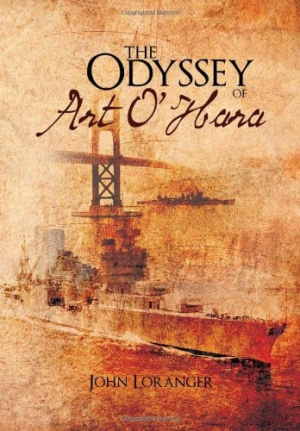The Odyssey of Art O'Hara
John Loranger knows how to start a story. From the very first line of his new novel, The Odyssey of Art O’Hara, he grabs readers and pulls them right along with his protagonist, Petty Officer Art O’Hara of the US Navy. The narrative is a chilling but realistic race with an outcome that is never quite certain until the end. Loranger, a former Navy man, based his story on the actual sinking of the USS Indianapolis during World War II, and here he has renamed the ship the Atwood and placed the fictional O’Hara onboard. The result is a convincing and credible tale of loss and bittersweet discovery that should be read straight through, in a single sitting.
Loranger’s O’Hara is a bit of a rogue. Having sneaked ashore for one last unauthorized evening of pleasure before shipping out, the seasoned sailor nearly misses the Atwood‘s departure. The irony, of course, is that being declared AWOL would not have been worse than the fate he encounters by making it to the cruiser with seconds to spare. There is something ominous about the scene Loranger exquisitely describes as the Atwood, with O’Hara onboard, makes its way out into the Pacific. The moon, pale as it sets, figures prominently throughout the rest of the story.
Dialogue among the crew is vivid, helping to develop and define the individual characters. O’Hara and his closest friends onboard are radiomen, and they joke and gripe together, but O’Hara is never as open with them as he appears. Alone, he is sometimes “sickened with dread,” knowing only that he does not want to die. When the Atwood is hit by torpedoes and begins to sink, survivors flee into the water, attempting to escape the suction as the ship goes down. O’Hara and his friends are among them.
Loranger skillfully captures the horror of the days that follow as the men fight for their lives. The elements, sharks, thirst, and delirium plague all the survivors, but most striking is the inhumanity that arises among them. Brutality and savagery threaten as insanity looms. O’Hara drifts in and out of consciousness, his harrowing circumstances causing a disassociation that leaves him wavering between believing he is dead and wishing to die. When he sleeps, vivid dreams of his past coalesce into scenes of normalcy, providing not only a backstory for his character but also an understanding that he himself has never seemed to possess: “Dreaming and imagining were fictions, but remembering was something else.” Guilt and forgiveness play out in his mind, and he recalls something a very special person once told him: “I do believe that death is not the end.”
The Odyssey of Art O’Hara is a beautiful book, deftly written with little in the way of excess commentary. Its grammatical flaws are few, with most resulting from the use of extra prepositions where they are not needed. “From out of” and “from off,” for instance, appear often. Still, the story flows and enthralls, and such errors are minor in the overall presentation of Loranger’s tale. Readers of high-school age and older will appreciate the drama and the tragedy of this fictionalized but very personal account of a dreadful event in US naval history.
Reviewed by
Cheryl Hibbard
Disclosure: This article is not an endorsement, but a review. The publisher of this book provided free copies of the book and paid a small fee to have their book reviewed by a professional reviewer. Foreword Reviews and Clarion Reviews make no guarantee that the publisher will receive a positive review. Foreword Magazine, Inc. is disclosing this in accordance with the Federal Trade Commission’s 16 CFR, Part 255.

